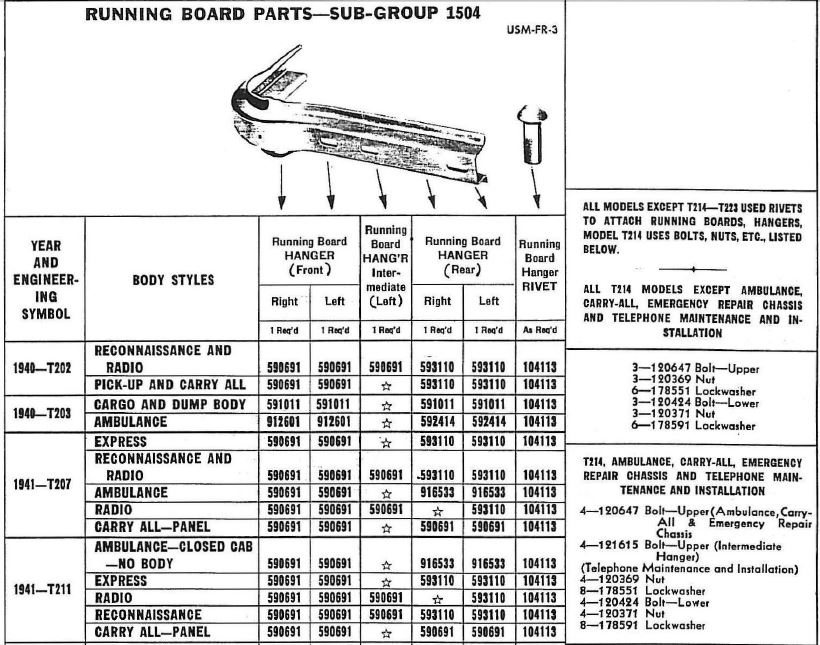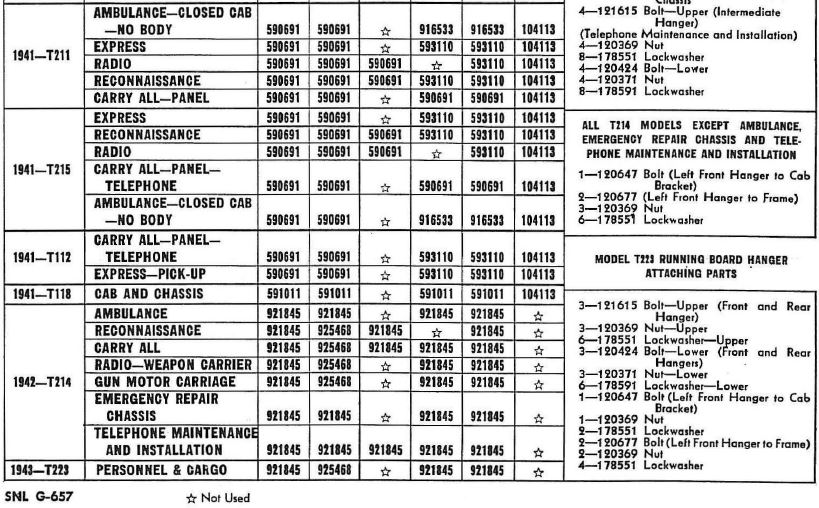Page 2 of 3
Re: 1/2 ton versus 3/4 ton
Posted: Sun Oct 14, 2018 1:27 pm
by Ernie Baals
All the vehicles in service were probably rebuilt at some time
From jeeps to tanks
Re: 1/2 ton versus 3/4 ton
Posted: Sun Oct 14, 2018 4:37 pm
by juan15
Good question.
I believe that there was no official reconstruction. I believe it is a change made by a person in a particular way. The reason?. I do not know. Possibly look for a model that he did not have ?. Possibly looking for a more priced sale, a higher price ?.
The reality is that it is not an original WC-56 vehicle. If you like it, go ahead, but knowing that you buy a chassis WC-51.
One thing is the origin of the factory and another is what the vehicle is now. What is not admissible is that a model is sold and then the buyer finds out that it is not.
What amazes me is that the seller offers a B.C., that corresponds to another model. Which may mean that the seller does not know that his vehicle is really a WC-51.
Re: 1/2 ton versus 3/4 ton
Posted: Sun Oct 14, 2018 8:37 pm
by Gordon_M
I was told many years ago by Alan Chapman that the French took a bunch of Command Cars and removed the bodies, then used the chassis and drivetrains to rebuild Weapon Carriers.
Pete Gray bought some loose Command bodies in France and sold a couple on to Alan, who sold one to me so I could use it on my WC56 which had been cut down on the sides.
Re: 1/2 ton versus 3/4 ton
Posted: Sun Oct 14, 2018 9:32 pm
by GlennV
@ Juan, i understand your reasoning, but it is the same as buying a reconditioned body (with lots of new sheat metal) of a ww2 jeep or even a new (MD J) body. Or vica versa, an original body with an adapted CJ or new repro chassis ..
In this case we know for sure that it is an original chassis ... also the chance of finding an original CC chassis (with papers) here in Europe is not so easy ..
I don't say i encourage this way of working, but because the part of the body is still original CC. I could be tempted to go this route to bring an original CC (body) back on the road ...
I will go and take a look tuesday evening ..
Glenn
Re: 1/2 ton versus 3/4 ton
Posted: Mon Oct 15, 2018 5:06 am
by juan15
I understand, but I do not like it. But that's what there is.
I am very lucky because I have a WC-56, which arrived in Europe, the Swiss army, in 1950 or 1952. And there they treated him very well. It is very original with his 76 years.
But I understand that there are few WC-56/57/58.
But that a vehicle that left the factory as WC-51, it should be a WC-51, but ...
I wish you luck.
B.R.,
Juan.
Re: 1/2 ton versus 3/4 ton
Posted: Mon Oct 15, 2018 4:16 pm
by Ernie Baals
Juan
it is well documented that almost of of the vehicles went through a depot overhaul at least once in there military career.
from Jeeps, to motorcycles to tanks. Damaged and worn out vehicles were rebuilt and repaired, And the military didn't car about build sheets lol
Ernie
Re: 1/2 ton versus 3/4 ton
Posted: Tue Oct 16, 2018 9:12 am
by FrankUSMC
I work at a military rebuild facility, 100% what Ernie said....
One of the few, Fran USMC RET
Re: 1/2 ton versus 3/4 ton
Posted: Tue Oct 16, 2018 9:23 am
by Gordon_M
There's not much that can guarantee a Command Car originally came that way, unless you buy it first and then get the Build Card ( they won't send a Build Card without proof you actually own the vehicle ). I suppose if the chassis number actually on the chassis matches a particularly original-looking dash plate showing the same chassis number, and a WC56/57/58 description line, you could be reasonably sure.
I believe if you have a full, complete, stripped chassis, the only difference is that the Weapon Carrier had the battery tray ( riveted?) in the engine compartment, so a battery tray, or evidence those holes had been used, would be a good guide. That said, I'd guess that the chassis would have arrived bare from the chassis plant, and the battery tray would have been riveted on at the same time they riveted the running board hangers. ( I recall being told the first real assembly job on the line was to fit the running board hangers )
Re: 1/2 ton versus 3/4 ton
Posted: Tue Oct 23, 2018 11:29 am
by motto
The battery tray in the engine compartment of the 6 Volt WC 51 & 52 was bolted in. The holes were in the chassis whether used or not. The L/H louvered engine side panel/ inner mudguard is also shaped to accommodate a battery. Whether the battery is in the engine compartment, R/H side box or on the running board makes no difference, the inner guard is the same part number with a simple filler piece bolted to it if the tray is not installed.
As far as I am aware there is no difference between the chassis used on the WC51 & 52 and the WC56,57 and 58 other than provision for winch on vehicles so equipped.
The running board hangers are also bolted.
David
Re: 1/2 ton versus 3/4 ton
Posted: Tue Oct 23, 2018 8:29 pm
by Ernie Baals
The running board brackets on my trucks are riveted on, not bolted
if yours are bolted they have been replaced
Re: 1/2 ton versus 3/4 ton
Posted: Wed Oct 24, 2018 6:15 am
by motto
Hi Ernie,
I am not familiar with 1/2 ton Dodges as they are not common in this country. Are they what you are referencing when you say that the running board support brackets are riveted on?
I Have had a great deal of experience with 3/4 ton WCs and a bit on 1-1/2 toners and have yet to see one of these trucks with riveted running board brackets.
I am always willing to learn and if I am wrong I would like to know.
David
Re: 1/2 ton versus 3/4 ton
Posted: Wed Oct 24, 2018 1:44 pm
by zepher11
I have seven half-ton Dodge WC frames and all of the running board brackets are riveted on the frame with the exception of one. However, I can see were the rivet were ground off one that specific frame.
Re: 1/2 ton versus 3/4 ton
Posted: Thu Oct 25, 2018 12:05 am
by motto
The story appears to be that the half ton running board supports were definitely riveted to the frame whilst on the 3/4 ton they were bolted in place. I have seen nothing to suggest otherwise including a look through David Doyle's books on Dodge production which hold a couple of clues if you look closely.
As ever I am willing to learn if evidence to the contrary comes to light.
David
Re: 1/2 ton versus 3/4 ton
Posted: Thu Oct 25, 2018 1:27 am
by zepher11
I sneaked a peek at the SNL G-657 after work. On page 280 it shows rivets for the half-ton series through T-215. The 3/4 ton trucks show a star indicating rivet = "Not Used" as noted at the bottom of the page. Also the page notes at the top right that: "ALL MODELS EXCEPT T214---T223 USED RIVETS TO ATTACH RUNNING BOARDS, HANGERS, MODELS T214 USES BOLTS, NUTS, ETC., LISTED BELOW."
I think I'm going to go with Ernie's interpretation.

I always learn something new when looking at the SNL:


Re: 1/2 ton versus 3/4 ton
Posted: Thu Oct 25, 2018 3:03 am
by motto
That clinches it Zeph, the conclusion I had arrived at was correct, 3/4 and 1-1/2 ton trucks did not use rivets to attach the running board hanger brackets. On the T214 and T223 trucks they were bolted on. No other interpretation is possible. The T214 series of vehicles includes WC56, 57 & 58 so bolted hangers on those trucks.
Thanks for laying the matter to rest.
David